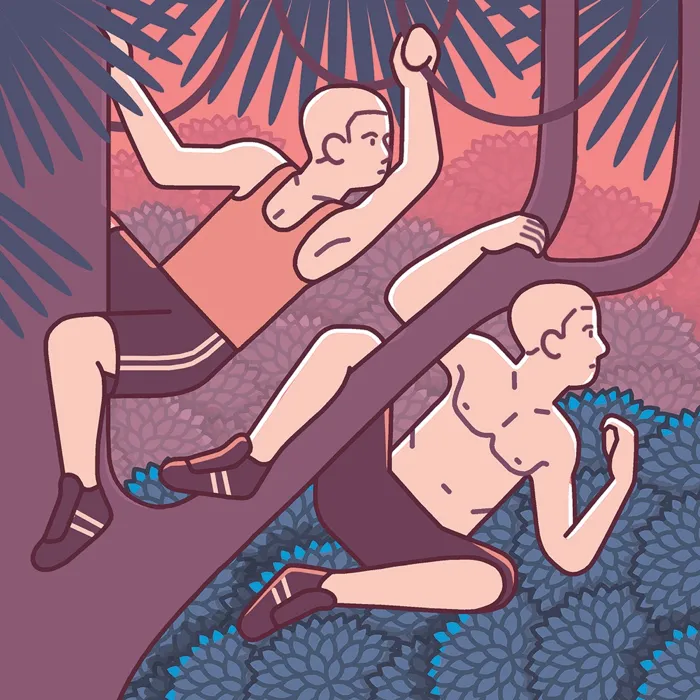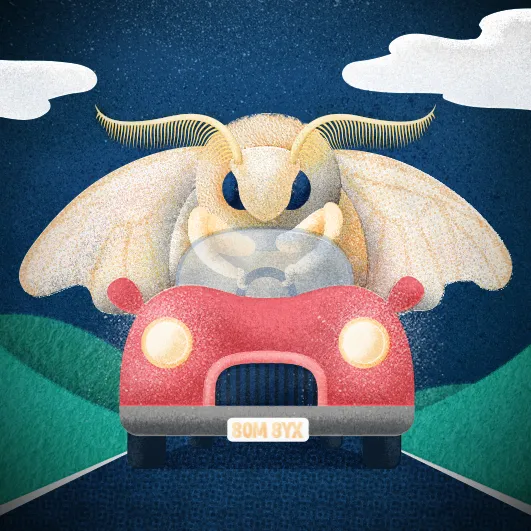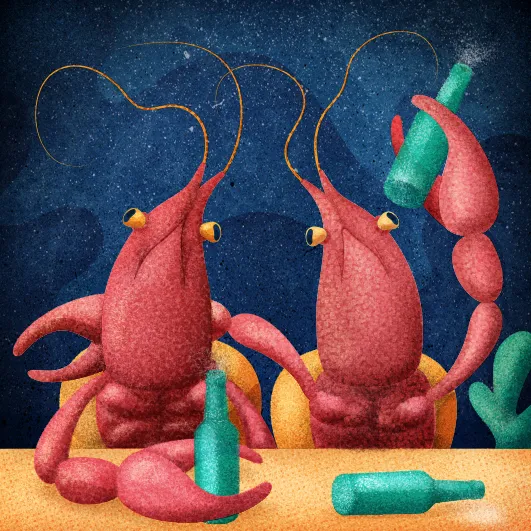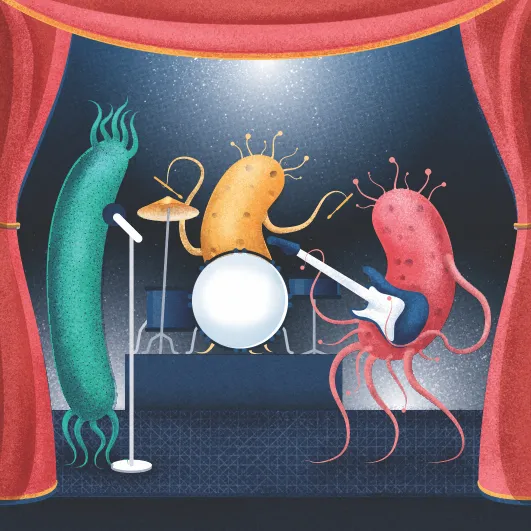The news has been filled with miracles of science this year, with exoplanets found across space, prehistoric humans uncovered and disease-free DNA discovered, but some have left us scratching our heads as to how they got funding in the first place.
Athletes told to take up swinging

They did what?!
A group of parkour athletes were asked to swing through trees like orangutans.
What did they do?
Researchers at the University of Roehampton set up an artificial canopy imitating the high branches of trees in a jungle, and monitored the energy use of parkourists – athletes who traverse urban environments – as they jumped, climbed and swung around it.
Why did they do that?
They wanted to investigate how different approaches to moving around in trees affected apes’ energy expenditure, to shed light on why some apes live on the ground and others in the trees. Doing this with real apes in the wild is difficult, so parkourists were the next best thing.
What did they find?
Climbing was found to consume the most energy. However, energy consumption when jumping and swinging varied according to branch stiffness, gap distance and the athlete’s size and weight. Further research is needed to determine what makes the orangutan ‘king of the swingers’…
Salamanders walk for miles on treadmills

What did they do?
Researchers from Ohio State University put two types of mole salamander on a treadmill, one type was born via male/female sexual reproduction, the other asexually from a single female, and ‘encouraged’ them to walk by poking them in the backside.
Why did they do that?
The team wanted to know more about how the salamanders procreate in order to help with conservation efforts.
What did they find?
The salamanders that were born via male/female reproduction were willing to walk up to four times as long as their asexually produced counterparts with some individuals trekking for more than 14 kilometres. The difference may be due to the asexually produced salamanders having less varied genes and lacking in those responsible for providing them with energy, the researchers say.
Moths taught to drive cars

What did they do?
A team from Tokyo University got male silkmoths to drive robotic cars towards the source of sex pheromones produced by a female. The moths were tethered to a treadmill linked to optical sensors that tracked their movements and steered the vehicle.
Why did they do that?
The scientists hope that the research will eventually lead to the development ofbiomimetic robotsthat can sniff out odours and locate their sources. Such robots could replace dogs and other animals used for detecting explosives
or drugs.
What did they find?
The moth drivers passed the test with flying colours, taking just two seconds longer than free-walking moths in finding the source of the scent. Though like most of us, they picked up a few minor faults.
‘Surrogate’ hens bred to lay other chickens’ eggs

What did they do?
A team at Edinburgh’s Roslin Institute used gene-editing tools to knock out the DDX4 part of hens’ genomes to create hens that are unable to produce their own eggs but are otherwise healthy.
Why did they do that?
For the next step, the researchers want to implant the hens with primordial germ cells – cells that lead to the production of eggs – from other breeds of chicken, enabling them to produce eggs of this other breed.
What do they want to do that for?
In the short term, the researchers hope that the technique can be used to protect rare breeds of poultry, but it could also be used to breed hens that can lay the eggs of other bird species in a bid to help conservation efforts.
Contagious itching triggered in mice

What did they do?
A team from Washington University played videos of chronically scratching mice to other mice. With a few seconds of seeing the video, the spectating mice would begin scratching too.
What did they find?
The itching behaviour is triggered by a structure in the mice’s brains called the suprachiasmatic nucleus (SCN) releasing a chemical called gastrin-releasing peptide (GRP) – a key transmitter of itch signals between the skin and the spinal cord. The behaviour is an instinct that the mice have no control over, according to the researchers.
Why did they do that?
It is hoped that the findings can help the researchers to deepen our understanding of the neural circuits that control socially contagious behaviour.
Nutritional value of human flesh calculated

What did they do?
Researchers at Brighton University analysed human flesh to find out its calorie content.
Why did they do that?
They wanted to investigate the motivations for past human species engaging in cannibalistic practices. There is currently debate as to whether the consumption of human flesh was for survival, psychotic, spiritual or dietary reasons.
What did they find?
A 65kg human has approximately 32,000 calories in their muscle tissue, compared
to 163,000 for a deer. This suggests that our ancestors were highly unlikely to hunt and consume members of their own species for strictly nutritional reasons, the researchers say.
Researchers got crayfish tipsy

How did they do that?
A team at the University of Maryland plunged two groups of social crayfish into a tank spiked with booze. Previously, one group had been housed together in a tank for 10 days, the other group had been kept in solitary conditions. The team observed the animals over three hours to determine how ‘drunk’ they were.
What did they find?
When crayfish are tipsy, they stand more upright and begin thrashing their tails around before finally flopping over onto their backs – a sight eerily similar to the scenes in UK town centres on a Friday night. The team found that it took larger quantities of alcohol to trigger drunken behaviour in the loner crayfish.
Why did they do that?
Though they are keen to stress the fact that the research is still in the preliminary stages, the researchers say that socially isolated humans could show a similar increased tolerance to the effects of alcohol. This could help to explain why those who spend a lot of time on their own often drink more heavily.
Mouse poo turned blue

What did they do?
A team at Harvard Medical School engineered gut bacteria in a group of mice to turn their poo blue when they are in the presence of disease.
How did they do that?
They engineered a harmless strain of E. coli bacteria to produce a particular enzyme when it came into contact with tetrathionate – a substance seen in high levels in the guts of people with ulcerative colitis. They were then able to identify the enzyme in the animals’ stools using a test in which it changes colour.
Why did they do that?
Understandably, many people aren’t exactly thrilled when they hear the words “You’re going to need an endoscopy”. However, there are currently few alternatives when it comes to diagnosing gut disorders. The team hopes that their technique can be used in place of uncomfortable and intrusive cameras to check for gut illnesses in those feelinga bit, er, off colour.
Robot taught to compose music

What did they do?
Computer scientists at Georgia Institute of Technology in the US have taught a robot to compose its own musical pieces, and then play them on the marimba – an instrument similar to a xylophone.
How did they do that?
The robot – nicknamed ‘Shimon’ – was fed nearly 5,000 complete compositions, ranging from pop songs to classical pieces, and over two million smaller fragments such as riffs, solos and codas. Using deep learning techniques, its AI system then analysed the material and devised its own set of rules for composition. Using these rules, it then ‘wrote’ and played recognisably musical creations of its own.
Why did they do that?
Project leader Mason Bretan is interested in exploring the possibilities of AI and computer learning in music composition. Maybe the first robot masterpiece is just around the corner –or maybe not…
Whales’ songwriting skills studied

What did they do?
A team at the University of Queensland listened in on the songs of a population of humpback whales, taking note of how the patterns, or verses, within them changed over time.
What did they find?
All males within a group sing the same song. However, the patterns change over time as they are altered by individual whales. Other whales in the group then learn these new verses and the new version, or remix, of the song quickly spreads through the group.
Why did they do that?
The study provides firm evidence of how animals learn complex behaviours and may help shed light on the evolution of human language, the researchers say.
Jellyfish made into ‘crisps’

What did they do?
A team of ‘gastrophysicists’ at the University of Southern Denmark created a new method for drying out jellyfish, turning them into edible ‘crisps’.
Why did they do that?
With the world’s population growing rapidly, it’s imperative we look into alternative sources of food, they say. Jellyfish have been eaten in Asia for thousands of years but the practice has never really taken off in the West, despite the relative abundance of the invertebrates. The researchers believe this may be due to the unusual texture created by the traditional processing procedure. In an attempt to overcome this, they used alcohol solutions to suck the water out of the jellyfish, leaving them similar in texture to potato crisps.
What did they find?
The researchers say the mouth feel and the aesthetic appearance of the jellyfish have “gastronomic potential” and that they actually taste pretty good. Hmm… we’ll stick to ready salted for the time being.
Human microbiome turned into music

What did they do?
A team of synthetic biologists and musicians calling themselves Biota Beats created a piece of music using the human microbiome – the symbiotic microbial cells, mostly made up of bacteria, that live on and in the human body.
How did they do that?
The team took swabs of bacteria from their armpits, belly buttons, feet, mouths and private parts and placed them on a petri dish shaped like a vinyl record and let them grow. They then used a mathematical algorithm to translate the images of the bacteria colonies into sounds with a different sound or ‘instrument’ belonging to each colony.
What does it sound like?
The end result is a spooky ambient electronic symphony that sounds eerily like the sort of thing Aphex Twin might come up with. Have a listen for yourself atbiotabeats.org.
Fishes’ serenades sabotaged

What did they do?
A team at the University of Gothenburg blasted captive common gobies, fish that live in the coastal waters of Sweden, with simulations of leisure boat engine noise.
Why did they do that?
A male goby builds a nest out of empty shells to attract females. When a female comes to inspect it, the male sings a serenade to win her over. If the female deems the male to be suitable, she will spawn in the male’s nest. As the use of leisure boats is growing, the team wanted to investigate the potential effects of noise on the mating habits of nearby marine life.
What did they find?
The fish in the noisy tank mated less, and took longer to mate, than the fish in a quiet aquarium.
Sheep trained to recognise celebrities

What did they do?
A team at the University of Cambridge placed eight sheep in a pen, one at a time. At one end, they displayed two photographs on computer screens – one of a celebrity and one of a random person – and placed infrared detectors on each of them. The celebrities used were Fiona Bruce, Jake Gyllenhaal, Barack Obama and Emma Watson. When the sheep moved towards the celebrity photograph they received a food reward. If they chose the wrong photograph, a buzzer would sound and they would receive nothing.
What did they find?
After training, the sheep were able to choose the photograph of the celebrity face eight times out of ten from the front, and around seven times out of ten when show the face from the side.
Why did they do that?
“Sheep are long-lived and have brains that are similar in size and complexity to those of some monkeys. That means they can be useful models to help us understand disorders of the brain, such as Huntington’s disease, that develop over a long time and affect cognitive abilities,” said study leader Prof Jenny Morton.